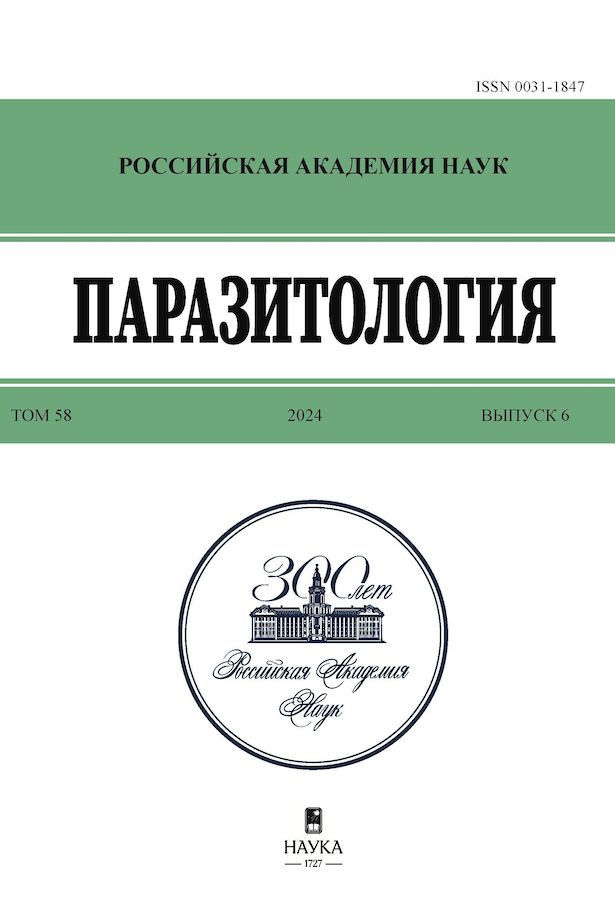Species composition and ecological features of bat flies (Nycteribiidae, Diptera), parasites of bats (Vespertilionidae, Chiroptera) in the center of the European part of Russia (Vladimir Province)
- Authors: Pavlov A.V.1,2, Bykov Y.A.2
-
Affiliations:
- ФГБУК «Государственный Владимиро-Суздальский историко-архитектурный и художественный музей-заповедник»
- ФГБУ «Национальный парк «Мещера»»
- Issue: Vol 58, No 6 (2024)
- Pages: 487–496
- Section: Articles
- URL: https://kld-journal.fedlab.ru/0031-1847/article/view/670130
- DOI: https://doi.org/10.31857/S0031184724060036
- EDN: https://elibrary.ru/vjuwwl
- ID: 670130
Cite item
Abstract
The material for this work was based on our collection of nycteribiid flies that we obtained during bat banding in the Vladimir region in 2016–2023. A total of 1308 bats belonging to 11 species were examined. In the process of banding bats, three species of blood-sucking flies from the family Nycteribiidae parasitizing bats were discovered: Basilia nattereri Kolenati, 1857, Penicillidia monoceros Speiser, 1900, Nycteribia kolenatii Theodor et Moscona, 1954. The most widespread and frequently encountered species of nycteribiidae is Nycteribia kolenatii.
Full Text
About the authors
Aleksandr V. Pavlov
ФГБУК «Государственный Владимиро-Суздальский историко-архитектурный и художественный музей-заповедник»; ФГБУ «Национальный парк «Мещера»»
Author for correspondence.
Email: muha2_1977@mail.ru
Russian Federation, ул. Большая Московская 43, Владимир, 600000; ул. Интернациональная 111, г. Гусь-Хрустальный, 601500
Yuri A. Bykov
ФГБУ «Национальный парк «Мещера»»
Email: muha2_1977@mail.ru
Russian Federation, ул. Интернациональная 111, г. Гусь-Хрустальный, 601500
References
- Богданов О.П. 1953. Фауна Узбекской ССР. Млекопитающие. Рукокрылые. Ташкент, Издательство Академии наук УзССР, т. 3, вып. 2, 160 с. [Bogdanov O.P. 1953. Fauna Uzbekskoi SSR. Mlekopitayushchie. Rukokrylye. Taschkent, Izdatelstvo Akademii nauk UzSSR, 3(2): 160 s. (in Russian)].
- Иванчева Е.Ю., Иванчев В.П. 2000. Рукокрылые Рязанской области. Plecotus 3: 85–93. [Ivantscheva E.Yu., Ivantschev V.P. 2000. Rukokrylye Ryazanskoy oblasti. Plecotus 3: 85–93. (in Russian)].
- Красная книга Владимирской области. 2018. Тамбов, ООО «ТПС», 432 с. [Krasnaya kniga Vladimirskoy oblasti. 2018. Tambov, OOO «TPS», 432 s. (in Russian)].
- Ларченко А.И., Горобейко У.В., Маковецкая Е.В., Кирьянов П.С. 2024. Видовой состав, распространение, хост-специфичность, морфологические и генетические особенности мух кровососок рукокрылых (Diptera, Nycteribiidae) в Беларуси. Юг России: экология, развитие 19 (2): 40–56. [Larchanka A.I., Gorobeyko U.V., Makovetskaya E.V., Kiryanov P.S. 2024. Species composition, distribution, host-specificity, morphological and genetic characteristics of bat flies (Diptera, Nycteribiidae) in Belarus. South of Russia: ecology, development 19(2): 40–56. (in Russian)]. https://doi.org/10.18470/1992-1098-2024-2-5
- Млекопитающие Казахстана. 1985. Насекомоядные и рукокрылые. Алма-Ата, Наука, т. 4 : 280 с. [Mlekopitayushchie Kazakhstana. 1985. Nasekomoyadnye i rukokrylye. Alma-Ata, Nauka, 4: 280 s. (in Russian)].
- Орлова М.В., Чистяков Д.В., Орлов О.Л., Крюгер Ф., Кшнясев И.А. 2014. Фауна эктопаразитов прудовой ночницы Myotis dasycneme (Boie, 1825), (Chiroptera, Vespertilionidae) северной Евразии. Вестник СПбГУ 3(1): 24–38. [Orlova M.V., Chistiacov D.V., Orlov O.L., Kruger F., Kshnyasev I.A. 2014. Ectoparasite fauna of pond bat Myotis dasycneme (Boie, 1825), (Chiroptera, Vespertilionidae) in northern Eurasia. Vestnik SPbGU 3(1): 24–38. (in Russian)].
- Павлов А.В., Быков Ю.А. 2020. К познанию фауны и экологии двукрылых (Diptera, Nycteribiidae) паразитов летучих мышей в центре европейской части России. XI Всероссийский диптерологический симпозиум. СПБ, 177–179. [Pavlov A.V., Bykov Yu.A. 2020. To the knowledge of the fauna and ecology of dipterans (Diptera, Nycteribiidae) bat parasites in the center of the european part of Russia. XI All-Russian Dipterological Symposium. SPB, 177–179. (in Russian)].
- Фарафонова Г.В. 1997. Жизненная схема мух-паучниц (Diptera, Nycteribiidae) у северных границ их ареала. Место и роль двукрылых насекомых в экосистемах. СПБ, 123–124. [Farafonova G.V. 1997. Life cycle of bat flies (Diptera, Nycteribiidae) near northern limits of their distribution. Diptera (Insecta) in ecosystems. SPB, 123–124. (in Russian)].
- Dick C.W., Patterson B.D. 2006. Bat flies: obligate ectoparasites of bats. Micromammals and macroparasites: from evolutionary ecology to management. Tokyo, 179–194. [in English].
- Diets C., von Helversen O. 2004. Illustrated identification key to the bats of Europe. Electronic publication. 144 p. [in English].
- Haitlinger R. 1979. Pasozyty zewnetrzne nietoperzy Dolnego Slaska. VI. Acarina, Siphonaptera, Diptera (Nycteribiidae). Wiadomosci parasitologiezne 25: 119–130. [in Polish].
- Hofstede H.M., Fenton M.B. 2005. Relationships between roost preferences ectoparasite density and grooming behavior of Neotropical bats. J. Zool. Lond. 266: 333–340. [in English].
- Kunz T.H. 1982. Ecology of bats. New York, 51 pр. [in English].
- Marshall A.G. 1971. The ecology of Basilia hispida (Diptera, Nycteribiidae) in Malaysia. J. Anim. Ecol. 40: 141–154. [in English].
- Marshall A.G. 1981. The ecology of ectoparasitic insect. New York, 459 pp. [in English]
- Mlynarova L., Korytar L., Manko P., Ondrejkova A., Prokeš M., Smolak R., Oboňa J. 2023. Updated Taxonomic Key of European Nycteribiidae (Diptera), with a Host-Parasite Network. Diversity 15(573) [in English]. https://doi.org/10.3390/d15040573
- Orlova M.V., Klimov P.B., Moskvitina N.S., Orlov O.L., Zhigalin A.V., Smirnov D.G., Dzhamirzoyev H.S., Vekhnik V.P., Pavlov A.V., Emelyanova A.A., Khristenko E. 2021. New records of bat flies (Diptera: Nycteribiidae), with an updated checklist of the nycteribiids of Russia. Zootaxa 4927 (3): 410–430. [in English]. https://doi.org/10.11646/zootaxa.4927.3.5
- Szentivanyi T., Estok P., Földvari M. 2016.Checklist of host associations of European bat flies (Diptera: Nycteribiidae, Streblidae). Zootaxa 4205 (2): 101–126. [in English]. https://doi.org/10.11646/zootaxa.4205.2.1
Supplementary files















